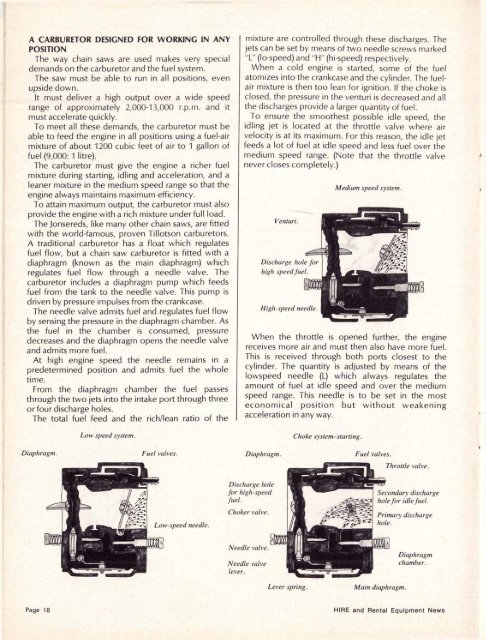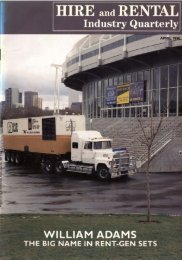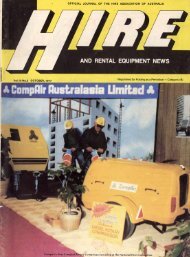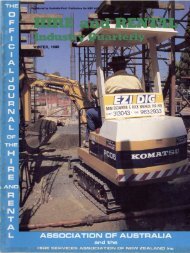new products - Hire and Rental Industry Association
new products - Hire and Rental Industry Association
new products - Hire and Rental Industry Association
Create successful ePaper yourself
Turn your PDF publications into a flip-book with our unique Google optimized e-Paper software.
A CARBURETOR DESIGNED FOR WORKING IN ANY<br />
POSITION<br />
The way chain saws are used makes very special<br />
dem<strong>and</strong>s on the carburetor <strong>and</strong> the fuel system.<br />
The saw must be able to run in all positions, even<br />
upside down.<br />
It must deliver a high output over a wide speed<br />
range of approximately 2,000-13,000 r.p.m. <strong>and</strong> it<br />
must accelerate quickly.<br />
To meet all these dem<strong>and</strong>s, the carburetor must be<br />
able to feed the engine in all positions using a fuel-air<br />
mixture of about 1200 cubic feet of air to 1 gallon of<br />
fuel (9,000:1 litre).<br />
The carburetor must give the engine a richer fuel<br />
mixture during starting, idling <strong>and</strong> acceleration, <strong>and</strong> a<br />
leaner mixture in the medium speed range so that the<br />
engine always maintains maximum efficiency.<br />
To attain maximum output, the carburetor must also<br />
provide the engine with a rich mixture under full load.<br />
The Jonsereds, like many other chain saws, are fitted<br />
with the world-famous, proven Tillotson carburetors.<br />
A traditional carburetor has a float which regulates<br />
fuel flow, but a chain saw carburetor is fitted with a<br />
diaphragm (known as the main diaphragm) which<br />
regulates fuel flow through a needle valve. The<br />
carburetor includes a diaphragm pump which feeds<br />
fuel from the tank to the needle valve. This pump is<br />
driven by pressure impulses from the crankcase.<br />
The needle valve admits fuel <strong>and</strong> regulates fuel flow<br />
by sensing the pressure in the diaphragm chamber. As<br />
the fuel in the chamber is consumed, pressure<br />
decreases <strong>and</strong> the diaphragm opens the needle valve<br />
<strong>and</strong> admits more fuel.<br />
At high engine speed the needle remains in a<br />
predetermined position <strong>and</strong> admits fuel the whole<br />
time.<br />
From the diaphragm chamber the fuel passes<br />
through the two jets into the intake port through three<br />
or four discharge holes.<br />
The total fuel feed <strong>and</strong> the rich/lean ratio of the<br />
Low speed system.<br />
Diaphragm. Fuel valves.<br />
Page 18<br />
mixture are controlled through these discharges. The<br />
jets can be set by means of two needle screws marked<br />
"L" (lo-speed) <strong>and</strong> "H" (hi-speed) respectively.<br />
When a cold engine is started, some of the fuel<br />
atomizes into the crankcase <strong>and</strong> the cylinder. The fuelair<br />
mixture is then too lean for ignition. If the choke is<br />
closed, the pressure in the venturi is decreased <strong>and</strong> all<br />
the discharges provide a larger quantity of fuel.<br />
To ensure the smoothest possible idle speed, the<br />
idling jet is located at the throttle valve where air<br />
velocity is at its maximum. For this reason, the idle jet<br />
feeds a lot of fuel at idle speed <strong>and</strong> less fuel over the<br />
medium speed range. (Note that the throttle valve<br />
never closes completely.)<br />
Medium speed system.<br />
When the throttle is opened further, the engine<br />
receives more air <strong>and</strong> must then also have more fuel.<br />
This is received through both ports closest to the<br />
cylinder. The quantity is adjusted by means of the<br />
lowspeed needle (L) which always regulates the<br />
amount of fuel at idle speed <strong>and</strong> over the medium<br />
speed range. This needle is to be set in the most<br />
economical position but without weakening<br />
acceleration in any way.<br />
Choke system-starting.<br />
Diaphragm. Fuel valves.<br />
Lever spring. Main diaphragm.<br />
HIRE <strong>and</strong> <strong>Rental</strong> Equipment News





